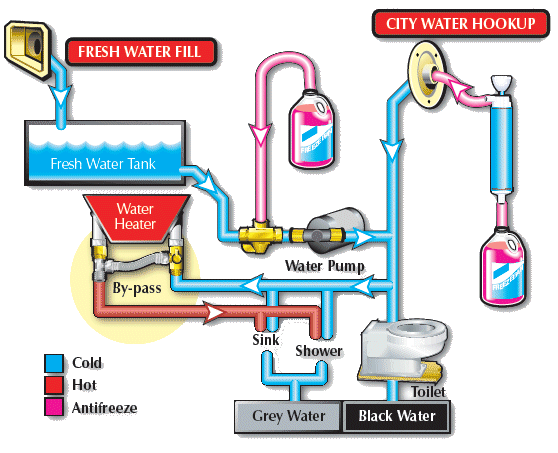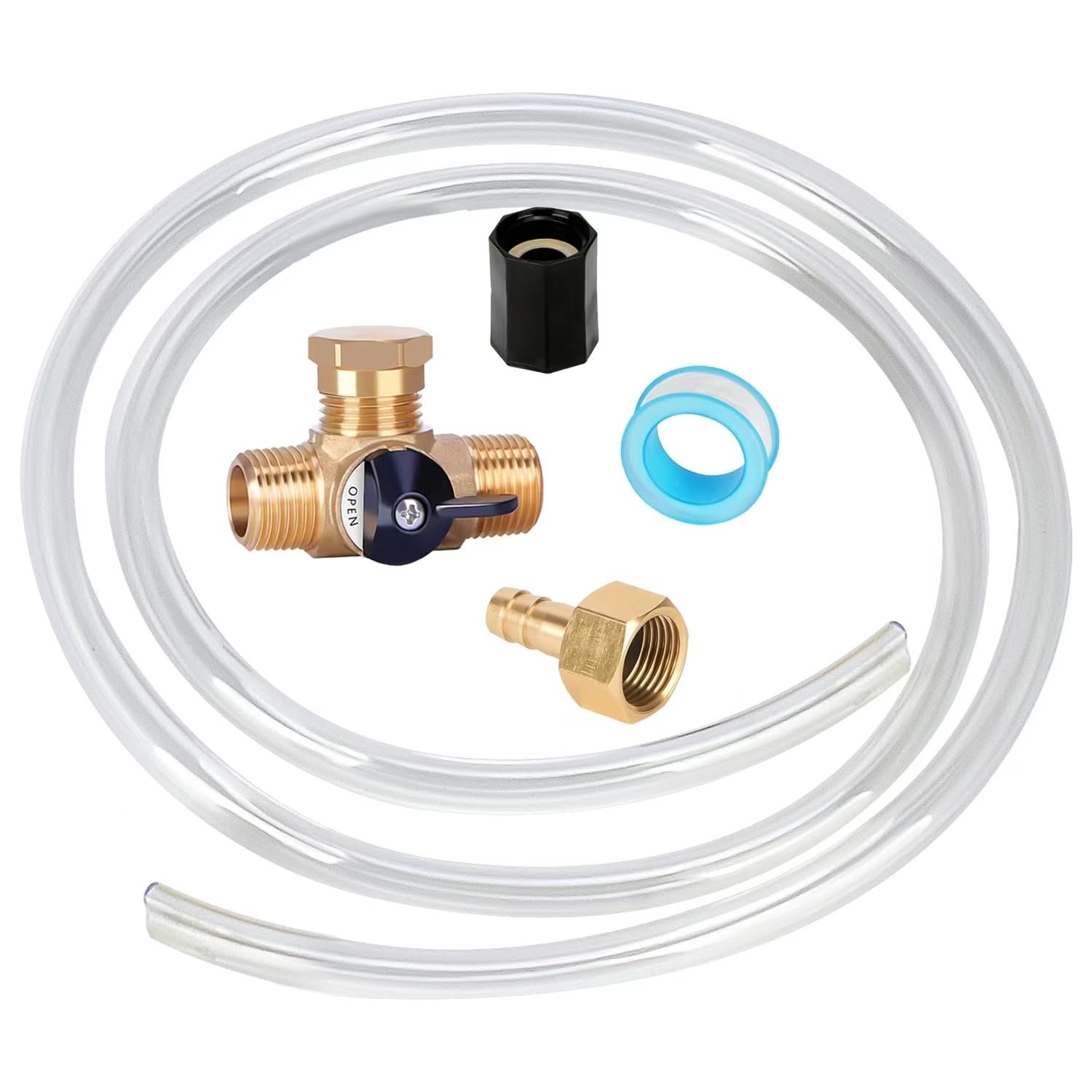Winterizing your RV is crucial for its longevity. How much antifreeze do you need?
Typically, you will need about 2-3 gallons of RV-specific antifreeze. Winterizing your RV ensures that it is protected from freezing temperatures. It prevents damage to the plumbing system and other components. Using the right amount of antifreeze is key to this process.
Too little can leave your RV vulnerable, while too much is wasteful. Understanding how to properly winterize your RV can save you from costly repairs and headaches in the future. In this guide, we will explain the steps to determine the right amount of antifreeze for your RV. This will help you prepare your RV for winter, so it remains in great shape for your next adventure.

Credit: gagscamperway.com
Preparing Your Rv For Winter
Winter is coming. Your RV needs proper preparation to survive the cold months. Winterizing your RV prevents damage from freezing temperatures. One essential step is adding antifreeze. This guide will help you get ready.
Inspecting The Rv
Start by inspecting your RV. Check for any leaks or damage. Ensure all seals are intact. Look at windows, doors, and the roof. Fix any issues before proceeding.
| Area | What to Check |
|---|---|
| Windows | Ensure seals are intact |
| Doors | Check for proper closing |
| Roof | Look for any leaks |
Gathering Necessary Supplies
Next, gather all necessary supplies. You will need RV antifreeze, a water pump converter kit, and basic tools.
- RV antifreeze
- Water pump converter kit
- Basic tools
Make sure you have enough antifreeze. It typically takes 2-3 gallons. Check your RV’s manual for specific requirements.
Now you’re ready to winterize your RV. Follow the steps carefully. This ensures your RV remains in great condition.
Understanding Antifreeze
Winterizing your RV is crucial to protect it from cold weather damage. Understanding antifreeze is key to this process. This guide will help you learn about the different types and the importance of antifreeze in winterizing your RV.
Types Of Antifreeze
There are two main types of antifreeze used for RVs: propylene glycol and ethanol-based antifreeze. Each type has its own benefits and uses.
- Propylene Glycol: This type is non-toxic and safe for use in potable water systems. It is environmentally friendly and provides excellent protection against freezing and corrosion.
- Ethanol-Based Antifreeze: This type is less expensive but can be toxic if ingested. It is often used in non-potable water systems and provides adequate freeze protection.
Choosing the right antifreeze for your RV depends on your specific needs and budget.
Why Antifreeze Is Important
Antifreeze is essential for protecting your RV’s plumbing and engine during winter. Water left in the pipes and tanks can freeze, expand, and cause costly damage.
- Prevents Freezing: Antifreeze lowers the freezing point of water, preventing it from freezing in your RV’s plumbing system.
- Prevents Corrosion: It also helps to prevent rust and corrosion in the pipes and engine.
- Ensures Safety: Using the right antifreeze ensures that your water system remains safe for use when you de-winterize your RV.
Properly winterizing your RV with antifreeze will save you time and money. It will also ensure your RV is ready for your next adventure.
Determining The Right Amount
Winterizing your RV is crucial to prevent damage from freezing temperatures. Using the right amount of antifreeze is key. This guide will help you determine how much antifreeze you need for your RV.
Calculating Antifreeze Needs
To calculate the amount of antifreeze required, consider the following:
- Drain all water from the system. This includes pipes, tanks, and water heaters.
- Measure the capacity of your fresh water tank. This is typically listed in your RV manual.
- Check the capacity of your water heater. This information is also in the manual.
- Estimate the length of your water lines. Longer lines mean more antifreeze.
A typical RV uses about 2-3 gallons of antifreeze. If your RV is larger or has more water lines, you may need more.
Considering Rv Size
The size of your RV affects how much antifreeze you need. Larger RVs with more plumbing require more antifreeze. Use the following table as a general guide:
| RV Size | Antifreeze Needed |
|---|---|
| Small (up to 20 feet) | 2 gallons |
| Medium (20-30 feet) | 3-4 gallons |
| Large (over 30 feet) | 5-6 gallons |
Always add a little extra antifreeze to ensure complete coverage. It’s better to have too much than too little. Properly winterizing your RV protects it from damage and extends its life.

Credit: pantherrvproducts.com
Draining The Water System
Draining the water system is essential for winterizing your RV. Water left in the system can freeze and cause damage. Follow these steps to ensure your RV is ready for winter.
Emptying Water Tanks
First, empty the fresh water tank. Open the drain valve and let the water flow out. Next, drain the grey and black water tanks. Use a sewer hose to empty them at a dump station. Rinse the tanks thoroughly with clean water.
Blowing Out Water Lines
After emptying the tanks, blow out the water lines. Use an air compressor for this task. Attach the compressor to the city water inlet. Set the pressure to 30-40 psi. Open each faucet one by one. This will push out any remaining water. Don’t forget the shower and toilet. Ensure all the water lines are completely dry.
Adding Antifreeze To The System
Winterizing your RV is crucial to prevent damage during cold weather. Adding antifreeze to the system protects your pipes and tanks. This step ensures your RV remains in good condition throughout the winter season.
Using A Water Pump Converter Kit
A water pump converter kit simplifies the antifreeze process. Start by turning off the water supply to your RV. Attach the converter kit to your water pump. This kit allows you to draw antifreeze directly from the container. Open all faucets and valves in your RV. This includes sinks, showers, and toilets. Turn on the pump and let the antifreeze flow through the system. Check each faucet for pink liquid to ensure antifreeze has reached all parts. Once done, turn off the pump and close all faucets.
Pouring Antifreeze Manually
Manually pouring antifreeze is another option. Begin by draining all water from the system. Use the low-point drains to remove residual water. Close the drains once water stops flowing. Open all faucets and valves to relieve pressure. Pour antifreeze into the fresh water tank. Use a funnel to avoid spills. Turn on the water pump to circulate the antifreeze. Check for pink liquid at each faucet. Repeat the process until all outlets show antifreeze. Finally, flush toilets and run the shower to ensure complete coverage.
Protecting Appliances
Protecting your RV’s appliances during winter is crucial. Frozen pipes and tanks can cause costly damage. Ensuring appliances are winterized prevents this. The steps are simple but necessary. Follow them to keep your RV in top condition.
Winterizing The Water Heater
First, turn off the water heater. Let it cool completely. Next, drain the water heater tank. Open the drain valve and remove the plug. Allow all water to flow out. Use a water heater bypass kit. This prevents antifreeze from entering the tank. It saves antifreeze and keeps the tank clean. Finally, close the drain valve and plug. Your water heater is now ready for winter.
Safeguarding The Refrigerator
Begin by turning off the refrigerator. Empty all food and clean the shelves. Leave the doors open. This prevents mold and mildew. Disconnect the refrigerator from power. If your RV is parked, unplug it. If it’s on battery, turn off the breaker. Cover the refrigerator vents. This keeps out pests and debris. Check the seals on the doors. Ensure they are tight and in good condition. Doing this keeps your refrigerator safe during the winter.
Final Checks
Final checks are essential to ensure your RV is ready for winter. These steps help you catch issues before they cause problems. Let’s dive into the final checks.
Inspecting For Leaks
First, inspect the RV for leaks. Check all hoses and connections. Look under sinks and near the water heater. Small leaks can cause big problems in winter. Use a flashlight for better visibility. Tighten any loose connections. Replace damaged hoses immediately.
Ensuring Even Distribution
Next, ensure the antifreeze is evenly distributed. Run the water pump to move the antifreeze through the system. Open each faucet, one at a time. Let the antifreeze flow until you see a steady stream. Don’t forget the shower and toilet. Also, run antifreeze through any outdoor faucets or showers. This step protects all parts of your plumbing system.
Storage Tips
As winter approaches, it’s essential to think about proper storage tips for your RV. These tips help protect your vehicle from the harsh winter elements. Proper storage can save you money on repairs and keep your RV in great shape for your next adventure. Let’s dive into some key storage strategies.
Choosing A Storage Location
Picking the right storage spot is crucial. Consider these factors:
- Indoor storage: Offers the best protection from the elements.
- Covered storage: Shields your RV from snow and rain.
- Outdoor storage: More affordable, but ensure a weather-resistant cover.
When selecting a location, think about security. A fenced and well-lit area can deter theft and vandalism. Proximity to your home is another factor. Closer locations make it easier to check on your RV periodically.
Covering Your Rv
Covering your RV is a must to keep it safe from winter weather. Here are some tips:
- Use a breathable RV cover. It prevents mold and mildew.
- Secure the cover with straps. This prevents it from blowing away.
- Cover all vents and openings. It keeps pests out.
A good quality cover can extend your RV’s lifespan. It protects the roof, windows, and exterior from snow and ice. Investing in a high-quality cover pays off in the long run.

Credit: www.amazon.com
Frequently Asked Questions
How Much Antifreeze Is Needed To Winterize An Rv?
Typically, 2 to 3 gallons of RV antifreeze is enough. The exact amount depends on your RV’s plumbing system.
Can I Use Car Antifreeze In My Rv?
No, use only RV-specific antifreeze. Car antifreeze is toxic and not safe for your RV’s water system.
When Should I Winterize My Rv?
Winterize your RV before freezing temperatures hit. Usually, this is in late fall or early winter.
What Type Of Antifreeze Is Best For Rv?
Non-toxic, propylene glycol-based antifreeze is best. It is safe for potable water systems and effective against freezing.
Conclusion
Winterizing your RV is crucial for protecting it in cold weather. Use the right amount of antifreeze to avoid damage. Too little antifreeze can lead to freezing pipes. Too much is wasteful and costly. Follow manufacturer guidelines for the best results.
Store your RV in a safe place. Regular maintenance extends the life of your RV. Enjoy peace of mind knowing your RV is winter-ready. Keep it simple, stay prepared, and happy travels!




